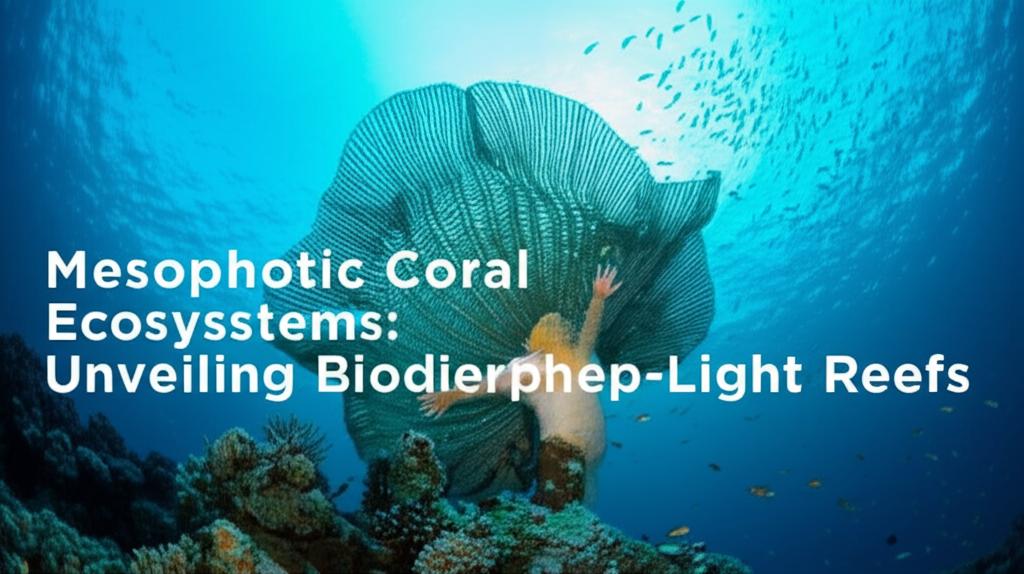Dive into the "twilight zone" of the ocean, and you'll discover a world largely hidden from view, yet teeming with life: mesophotic coral ecosystems. These "middle light" reefs, typically found at depths between 30 and 150 meters (roughly 100 to 500 feet), are a frontier of marine discovery, revealing a surprising wealth of biodiversity that is both unique and vital.
For a long time, these deeper reef systems were considered mere extensions of their shallower counterparts. However, recent advances in diving technology, including remotely operated vehicles (ROVs) and specialized rebreather diving gear, have peeled back the curtain on these enigmatic ecosystems. What scientists are finding is a world apart, with distinct communities of corals, sponges, algae, and fish that are often significantly different from those found in sun-drenched shallow waters.
A Hotspot of Unique LifeOne of the most captivating aspects of mesophotic reefs is their high rate of endemism – species found nowhere else on Earth. Studies in places like Hawaii have revealed that deep coral reefs can harbor twice as many unique fish species compared to their shallow-water equivalents. In some areas, like the Papahānaumokuākea Marine National Monument, endemism levels in mesophotic zones approach an astonishing 100%, the highest recorded in any marine ecosystem globally. These "twilight reefs" are not just home to rare fish; new species of crustaceans, corals, and sponges are also regularly being identified. For instance, a tiny crustacean, Cumella pagani, was recently discovered in the sediment of a Caribbean mesophotic ecosystem.
The corals themselves show remarkable adaptations to low-light conditions. Many species that form boulder-like structures in shallow waters adopt a flatter, plate-like growth form in mesophotic zones to maximize light absorption for their symbiotic algae. Some deep-water corals even fluoresce, displaying vibrant green and yellow glows, a phenomenon researchers now believe might help lure planktonic prey in the dim light.
More Than Just a Pretty Place: Ecological SignificanceThe importance of mesophotic coral ecosystems extends far beyond their fascinating biodiversity. They serve as a critical link between shallow reefs and the deep sea, providing habitat and food sources for a variety of species, including commercially important fish like snappers and groupers. In some regions, like the American Samoa, a staggering 80% of corals are found in mesophotic zones.
There's also been considerable discussion about whether these deeper reefs could act as refugia for shallow-water species threatened by climate change and other human impacts. The idea is that the cooler, more stable conditions at depth might offer a haven. While impacts like coral bleaching are generally less severe in deeper waters, mesophotic reefs are not entirely immune. Furthermore, recent research suggests that these ecosystems are often already "saturated," meaning that niches are filled by species specifically adapted to these unique low-light conditions, potentially limiting their capacity to shelter a wide array of shallow-water migrants. However, the connectivity between shallow and deep reefs, influenced by ocean currents and larval dispersal, remains an active area of research with important implications for conservation.
Challenges and the Future of DiscoveryDespite the growing body of knowledge, mesophotic coral ecosystems remain largely understudied. The logistical and financial challenges of accessing these depths mean that vast stretches, particularly in biodiversity hotspots like the Coral Triangle and the Indian Ocean, are still virtually unexplored. This knowledge gap hinders our ability to fully understand their ecological roles and to implement effective conservation strategies.
Scientists are calling for increased research efforts to map these ecosystems, understand their unique biodiversity, and assess their vulnerability to threats like fishing, pollution, and climate change. Discoveries like the vast, pristine coral reef found off the coast of Tahiti in 2022, thriving at depths of over 30 meters, offer glimmers of hope and underscore how much more there is to learn. Similarly, the recent mapping of the largest known deep-sea coral reef off the US Atlantic coast highlights the sheer scale of what may still be undiscovered.
Unveiling the secrets of mesophotic coral ecosystems is not just an academic pursuit; it's crucial for the future health of our oceans. As we continue to explore these deep-light reefs, we gain a deeper appreciation for the complexity and interconnectedness of marine life, and the urgent need to protect these hidden jewels of biodiversity.

